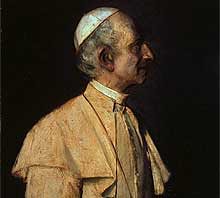Herewith the concluding installment on "Edification and Kneeling." It also contains the footnotes to the first two installments. I wanted to be sure I footnoted everything, so that guys like BF from Texas can prolong their enjoyment by perusing the linked sources . . . .
The Politics of Kneeling
All individual decisions have a political dimension, because no individual decision leaves the community untouched. Most of my "legal" arguments were addressed in my first post on this issue, and in subsequent correspondence with "Joe" and others. In the preceding part of this "essay" I've tried to explain the root of those legal arguments, the reasons for the continuing legitimacy of kneeling as preserved by the CDWDS. I have had hard words for them, and for the Bishops, but that is largely because I believe the Catholic life is a strong life which can stand hard words when they are warranted. (Certainly my Bishop and his Diocesan Newspaper believe this!) But the above is necessary, I think, to explain that an argument for continued kneeling under GIRM §160(2) & §43 is not a mere lawyerly quibble that indulges a taste for anachronism, or a shallow contrarianism masquerading as conservatism. Authentic conservatism does not believe so much in the treasures of the past as it does the possibility of treasure, and that conviction has sadly abandoned the authors and advocates of the GIRM's American adaptations. Kneeling and private prayer are not penitential customs or invitations to liturgical anarchy. They are holy customs, sacred ways, for they are intimately and communally Christological. One would rest easier under the new adaptations if one knew this was understood, and cherished, but gladly abandoned for a greater way to achieve the same goodness. (Cf. Matthew 19:21-22). Instead, one sees only a pungent campaign which combines the spiteful ahistoricism of Baptists with the glib badgering of animal-rights activists. It is a frightening thing to behold. But the failures of the community don't relieve the proponents of kneeling from answering some hard questions about their place in that community. I should like to try answering those questions, as raised by Shawn, in this part of my essay.
Lex orandi, lex credendi, "what is prayed is what is believed." Proponents of kneeling have a problem which, regrettably, is analogous to a feature of the debate between Traditional proponents of the Mass of St. Pius V and the Novus Ordo. It is the idea that one custom or practice is inherently more reverent than its alternative, an idea which inevitably suggests that those who lack the "right" custom are less reverent themselves. Witness my exchange with Shawn, via my email and his blogged reply:
SecretAgentMan: I am put in mind of what Julia told Winston in 1984 -- so long as you keep the little rules, you can break all the big ones. That seems to be the Diocesan Paper's editorial priority as well -- who cares if you put your fourteen-year-old daugher on the pill, so long as you keep her from kneeling to receive communion! And isn't it doubly-odd to imagine a fourteen-year-old girl who kneels to receive communion being on the pill to avoid getting pregnant by her fifteen-year-old boyfriends?
Shawn: I would not make the presumption that kneeling to receive communion would mitigate against what you have noted. I know of some fellow parishoners at SSPX who knelt to receive communion yet who went on to have children out of wedlock. Likewise, there were actually some modernists who preferred the Tridentine liturgy for aesthetic reasons over the Pauline liturgy. One should never consider any liturgy - or form of communion reception - to be a bulwark against error in and of itself. As long as there are flawed people in the equation, no law however sacred is safe from being contravened.
I was wrong, of course, and Shawn is right. If liturgical custom could cure sin, then grace is no more grace. But at the risk of seeming vain, there is a sense (not expressed in the exchange above) in which I may be right and Shawn may miss the mark. If Shawn were to match my intemperate outburst with his own and say that the merits of the new custom are irrelevant to the good life, then he would be saying that liturgy itself is meaningless. Even the sinner's hypocrisy is a tribute to virtue, to the permeability of our nature to custom, and to custom's ability to point us back to our true home. I would, in that case, submit that a pregnant teenaged girl who kneels before her God in the Eucharist both receives and gives a sign that is hidden from a halter-topped single girl who carries her unborn child with a bold confidence, escorted by singing acolytes, to claim "her sacrament." We learn what we are taught, and we are more frequently (and, usually, better) taught by customs than by dogmas. Within a mutual commitment to objective truth and enduring human reality, is there a way to avoid claiming superiority in reverence, preeminence in faith, upon "mere" differences in custom?
The answer, I believe, is "not always, but sometimes," and the difference is told less by debates about the merits of a particular custom than by a thorough understanding of the limits of human knowledge. The idea that custom is a wise and powerful teacher itself rests on the proposition that we must live realities which we do not explicitly or fully know. Custom is a form of government, and Washington's observation applies: It is like fire, a dangerous servant and a terrible master. Societies which are exclusively dominated by custom are stagnant and hostile to individual maturity, but societies which have no folkways are chaotic and characterized by extreme alienation. If customs were machines we would always know what to do with them, when to use them, what parts to change or when to paint them a different color. But customs are living things which have their root in a twilight, dreamy realm where rationality dozes under the ever-watchful gaze of truth. There are, of course, customs which are knowably, objectively wrong because they contravene such truth as can be known outside the ineffable mystery. Yet their number is, I think, far smaller than we imagine because our own culture induces us to make arguments about the "fittingness" of a custom in objective terms which are ultimately inappropriate. Many "Traditionalist" arguments about the Novus Ordo, with their unbearably strained attempts to go from culture into theology, fall into this category.
I don't believe I've followed my Traditionalist cousins in "Edification and Kneeling" because, first, I'm writing an adversarial brief for the preservation of what is primarily a cultural element in the liturgy. Assertive statements and critiques are part of that method, not necessarily a sign that culture is being used interchangeably with theology. Second, I have never made an argument that men are dogmatically (or even theologically) required to kneel to receive communion, or during the reception of others' communion. I hope I have fairly demonstrated that the USCC's liturgical/theological "authoritativeness" on this issue is purely de jure and is not to be confused with any significant degree of knowledge or cultural competence. But I would gladly submit all of us to the judgment of St. John Chrysostom, a Catholic who both lived and understood the Mass. The USCC can take great comfort in Chrysostom's Divine Liturgy, and the worshipful respect given to it by the faithful throughout millenia, because it clearly rules against granting a dogmatic place to kneeling in any part of the Mass. But however helpful Chrysostom's example may be, it cannot be the USCC's final and only answer to our questions unless the USCC is willing to commit the same fault which might (wrongly, I hope) be alleged against my own arguments, namely elevating culture into dogma.
If culture isn't identical to theology, then we shouldn't anchor our discussion solely to the binary presuppositions of theological discourse. That might be the largest flaw in the USCC's position, which discusses kneeling as though its place were mathematically dictated by dogmatic principles of eucharistic and ecclesiastical theology and as though any custom worthy of the name can be created by institutional decrees on behalf of theories invented by liturgical "working groups." Customs, after all, both express and experience truths and, therefore, customs represent something besides themselves. Perhaps we could give a limited place to Plato's criticism of art, laying its pejorative conclusions to one side while adopting its tolerance of at least some representational license. No column which looks straight can really be straight all the way to the top; any culture will have aspects that appear "inauthentic" or even "dangerous" to those who are unaware of the other cultural priorities and conventions which successfully keep oddity from becoming sacrilege. Seen in this aspect, our judgment of customs and cultures should, within a broad but discernable range of practice, become less confident, less dogmatic. The resulting openness was one of the central themes of Sacrosanctum Concilium itself, which is why my Bishop's invocation of the decree's provisions about accepting culture sounds so hollow in defense of his attempt to create one out of whole cloth. (But then, this is the United States, where we haven't had anything resembling a culture for a hundred years or more, so perhaps I can find some sympathy for his lese majeste).
This need not lead us to believe that all culture is equally wonderful and beneficent unless it can be condemned with quotations from Ott.[56] Even allowing for a tolerable range of practice, the refusal to dogmatize culture exposes culture to being objectively praised, worried over, or criticized. That process is, after all, one of the ways in which culture changes.[57] I do indeed submit that people who kneel for communion and engage in private prayer after receiving the Lord experience at least an opportunity for an awareness of the eucharistic mystery than those who don't. Conversely, there would be little point in the new GIRM adaptations unless they were thought of in a similar superior fashion. The difference is that neither my position nor my views of culture allow me to dogmatize my opinions into the basis for judgments about the spiritual lives of Catholics who practice another (admittedly established) culture. That is why Shawn so rightly took me to task for my outburst about teenaged girls who kneel to receive communion. It is also why I require that the same judgment be uttered against Bishops who issue ipso facto pronouncements of heresy and schism against kneeling Catholics. (If I am wrong to do a thing, I claim the criminal's privilege and insist that everyone else who does it be wrong themselves). We know enough to say that neither kneeling nor standing to receive the Eucharist is objectively disordered and an insufficient witness to eucharistic truth. We may know enough to say that one is better than another, or at least we may know enough to express our opinions with that degree of certainty which nonetheless accepts dispute and reproof. But we don't know enough to say that one custom makes a shipwreck of the faith while the other rides safe in the Barque of Peter. When it comes to certainty about the morality of culture, there are worlds of difference between prima nocte and kneeling in imitation of Christ in Gethsemane.
It is a sign of the uncertainty and instability, I dare say the individualism, of our age that such thoughts might be thought to call the whole idea of culture into question. If I say that culture can be evaluated in a non-binary framework, and that opposite practices can be wholesome alike, then haven't I just explained why culture is a synonym for anarchy? No, because if a habit or practice is to acquire the beneficial status of "culture" which I give, for example, to kneeling it must achieve things which are inconsistent with anarchy. First, it must represent an experience of truth. That fact alone ties it into a necessary relationship with all our experiences of truth and, hence, with truth itself. Second, it must represent an expression of some truth. That fact alone identifies culture with a communal relationship in which individual preference is not sovereign. A man may prefer to retain his shoes upon entering a Japanese home, or to eat his couscous from an individual bowl, but he may not without breaking the bonds of community woven by the culture in which he finds himself. Culture's connection to community and truth commands our deep respect, while its connection to human contingency makes its expression of truth and community vulnerable to criticism and growth. That is not anarchy. It's not neat, bureaucratically-divinized uniformity, but it's not anarchy.
"But," I anticipate the objection, "we need a consistent liturgical culture in the United States." Why? Especially if the "inconsistency" between two parishes, or two dioceses, lies in each following the Mass as Catholics have done for decades, if not centuries. It was once thought that a consistency of culture was a paramount benefit of the Catholic faith, and that where such culture did not exist, Catholicism was absent. Hence Cum data fuerit and its aftermath,[58] and hence Sacrosanctum Concilium and its recognition that authentic Catholicism does not require -- and, depending on the circumstances, may be harmed by -- a uniform liturgical culture. If we must have such a culture, then John Paul II was in error when he wrote: "[I]t is necessary that all the pastors and the other faithful have a new awareness, not only of the lawfulness but also of the richness for the Church of a diversity of charisms, traditions of spirituality and apostolate, which also constitutes the beauty of unity in variety: of that blended "harmony" which the earthly Church raises up to Heaven under the impulse of the Holy Spirit."[59] It is not "advisable," nor is it "preferable." It is necessary. Section 43 of the US-GIRM itself does not insist on that kind of uniformity with respect to "communion processions," or standing after the Agnus Dei, nor does Rome insist on it with respect to kneeling to receive communion under §160(2); I don't see how it can be maintained that diversity on such matters between and within Dioceses is somehow tolerable while diversity between parishes (or between most parishes and one parish) is somehow disastrous.
Still, if culture is a shared experience and expression, there is some level at which it must be uniformly followed. I think that, in this case, that level is the parish, and I agree with Shawn that "[T]o deliberately go against the manner whereby the particular church administers the sacrament viz standing or kneeling is a sign of hidden pride and manifested spiritual immaturity." I would add "likely" before "sign," simply because some people are dull enough, or scrupulous enough, to contravene a custom for other reasons. Why the parish? Because it is the lowest level at which one has a visible locus of Christ's authority in the person of the priest. Catholics can't have communities without priests, not real ones, anyhow. It's in our DNA, if you will, and so the parish is the natural ne plus ultra of John Paul's "blended ‘harmony' which the earthly Church raises up to Heaven under the impulse of the Holy Spirit."[60] All this, I think, is recognized implicitly by the CDWDS' refusal to allow the Bishops to enforce their decrees on the individual level of a parishioner who receives communion.
**************************************************
NOTES
[1] Bishops' Committee on the Liturgy Bulletin, "Postures and Gestures at Mass." The full text can be found here. (hereafter "Postures and Gestures at Mass").
[2] Id.
[3] General Instruction of the Roman Missal (GIRM) § 83. The full text can be found here.
[4] Tertullian, On Prayer, Chapter XXIII. The text can be found here.
[5] Eusebius, History of the Church, Book V, Chapter V. The text can be found here..
[6] Council of Nicea, Canon XX The text may be found here.
[7] Adrian Fortescue, The Mass: A Study of the Roman Liturgy, p. 375 (Albany: Preserving Christian Publications, 1999)
[8] Fortescue, The Mass, pp. 93-97.
[9] Divine Liturgy of the Holy Apostle and Evangelist Mark. The text can be found here.
[10] Divine Liturgy of St. John Chrysostom (emphasis supplied). The entire text can be found here.
[11] Id.
[12] See, e.g, Catholic Encyclopedia, Genuflexion (New York: Knights of Columbus, 1913). The full text can be found here.
[13] Psalm 2:10-12 (KJV).
[14] "Postures and Gestures at Mass."
[15] Job 38:3-7 (KJV)
[16] Catholic Encyclopedia, "Humility." (New York: Knights of Columbus, 1913). The on-line version of the article can be found here.
[17] See, e.g., Summa II(II) art. 161, q. 4.
[18] Id.
[19] Summa II(II) a. 162 qq. 6-7.
[20] Psalm 8:3-9 (KJV)
[21] Deitrich von Hildebrand, Transformation in Christ
[22] Nicholas Cardinal Wiseman, Pastoral Letter, 1849, quoted in Stang, Pastoral Theology, p. 127 (New York: Benzinger Brothers, 1897).
[23] Reproductions may be found in Weitzmann, The Icon, Plates 24 & 28 (New York: George Braziller, 1978).
[24] See Catholic Encyclopedia, Genuflexion.
[25] Bertrand de Jouvenel, Sovereignty (Indianapolis: Liberty Fund, 1984).
[26] "Postures and Gestures at Mass" (emphasis supplied).
[27] Canon XIX, Council of Orange. It may be found in Denzinger, or on line here. The interpolations are mine, but I believe they accurately convey the Council's points. For comparison, see the Catechism 1996-2005.
[28] "Postures and Gestures at Mass."
[29] Pope Pius XII, Mediator Dei ¶¶ 74, 81, 99 & 118 (1947). The full text can be found here.
[30] "Postures and Gestures at Mass."
[31] Canons of the Council of Orange, loc cit.
[32] "Postures and Gestures at Mass."
[33] John Paul II, Redemptor Hominis, § 20 (1979) The full text can be found here.
[34] Pope Paul VI, Apostolic Constitution Paenitemini (1966). The full text can be found here.
[35] "Postures and Gestures at Mass."
[36] Congregation for Divine Worship and Discipline of the Sacraments, Protocol #1322/02/L, 1 July 2002. The text may be found here.
[37] USCC, Bishops' Committee on the Liturgy Handout, More about GIRM, printed in The Prairie Catholic of the Diocese of New Ulm, Minnesota. The solicismic word "my" was omitted between "individual act of" and "faith and piety," but the meaning remains unchanged. The text can be found here.
[38] See, e.g. Catholic Encyclopedia, "Individualism," (New York: Knights of Columbus, 1913). The full text can be found here.
[39] Catholic Bishops Deal with New Phenomenon: An Older America. The text can be found here.
[40] Life Issues Forum "Living the Real Thing" by Theresa Notare. The text can be found here.
[41] "Empowered by the Spirit: Campus Ministry Faces the Future" A Pastoral Letter on Campus Ministry Issued by the National Conference of Catholic Bishops November 15, 1985 The text can be found here.
[42] Life Issues Forum "The Essential Equation" by Theresa Notare. The text can be found here.The text can be found here.
[43] Light and Shadows: Our Nation 25 Years After Roe v. Wade, A Statement of the National Conference of Catholic Bishops The text can be found here.
[44] The Continuing Importance of Humanae Vitae by Most Rev. James T. McHugh.The text can be found here.
[45] This particular statement does not appear to be available on line. I am indebted to Mr. David Curtin of Catholic Insight for the information and the quote. Mr. Curtin's article, Standing Up for Kneeling may be found here.
[46]BCL Newsletter, July 2, 2002. The full text can be found here.
[47] John Paul II, Veritatis Splendor, ¶¶ 32-33 (1993). The full text can be found here.
[48] John Paul II, Pastores Dabo Vobis, ¶ 7 (1992). The full text can be found here.
[49] John Paul II, Id., ¶ 8.
[50] This, of course, is an allusion to Yeats' Second Coming.
[51] Pius XII, Mystici Corporis ¶¶ 61-63 (1943). The full text can be found here.
[52] Constitution on the Sacred Liturgy Sacrosanctum Concilium, ¶ 10 (1963). The full text can be found here.
[53] Dogmatic Constitution on the Church Lumen Gentium, ¶ 42 (1964). The full text can be found here.
[54] Decree on the Ministry and Life of Priests Presbyterorum Ordinis, ¶¶ 5-6 (1965). The full text can be found here.
[55] Jacques Maritain, The Peasant of the Garonne: An Old Layman Questions Himself About the Present Time, pp. 218-19 (New York: Holt, Rienhart & Winston, 1968). Emphases are original.
[56] Ludwig Ott, Fundamentals of Catholic Dogma (St. Louis: B. Herder Publishers, 1962).
[57] Had the USCC bothered to actually make a case against the dreaded "privatization of the Mass" through personal prayer, and offered a thoughtful critique of the custom which recognized its fundamental solidarity as to the ends of Catholicism but which also pointed out the custom's unintended shortcomings in the current condition, a civil and familial discourse might have ensued leading to an organic development (or at least a quasi-organic development) of something approaching culture. It chose instead to cultivate its unique liturgical flower in the usual hot-house environment of carefully-selected "lay people," the predictable run of academics and scholars, and liturgically-correct clerics, and then hurl its Eucharistic Anathema from the Sinai of 3211 North 4th Street NE, Washington, DC 20017-1194 against any Catholic who dared kneel before the Golden Calf of "Privatizing Tridentine Spirituality." Only people who have lifetime job security think and act this way, and it's a tragedy of modern life that they're not only the same people who are most likely to indulge in that sort of behavior but also the same people whose effectiveness cannot generally survive the indulgence. That is, in fact, a good one-sentence history of the SSPX from both sides.
[58] A decree of the Holy See demanding clerical celibacy of eastern Catholics in the United States, issued in 1929 and resulting in the schism of many thousands of Ruthenian Christians in the United States. The circumstances surrounding the decree and schism are complex, and it would be inaccurate to characterize the schsim purely as a revolt against "cultural imperialism" without deeper theological causes. But its inclusion here is not amiss, either -- Cum Data Fuerit began a period of time in which almost anything that was not distinctively Roman in origin (like the iconostasis) was looked at as tantamount to ecclesiastical sedition.
[59] John Paul II, Ecclesia Dei Adflicta ¶ 5 (1988). The full text is available here.
[60] Id.
[61] This is proven by the fact that I had previously read (and published here) my opinion that Tertullian recorded a majority practice by Christians kneeling at Sunday Mass. I am indebted to Mr. E. Hamilton for pointing out my error, which is fairly common among the unschooled, of confusing "Sabbath / sabbato" when used by Church Fathers with "Sunday." If you read the quotation I provided with "Sabbath" instead of "Saturday" you'll see the inducement to my error. Fortunately, Mr. Hamilton was kind enough to read my blog and provide criticism, which may be found here.











No comments:
Post a Comment